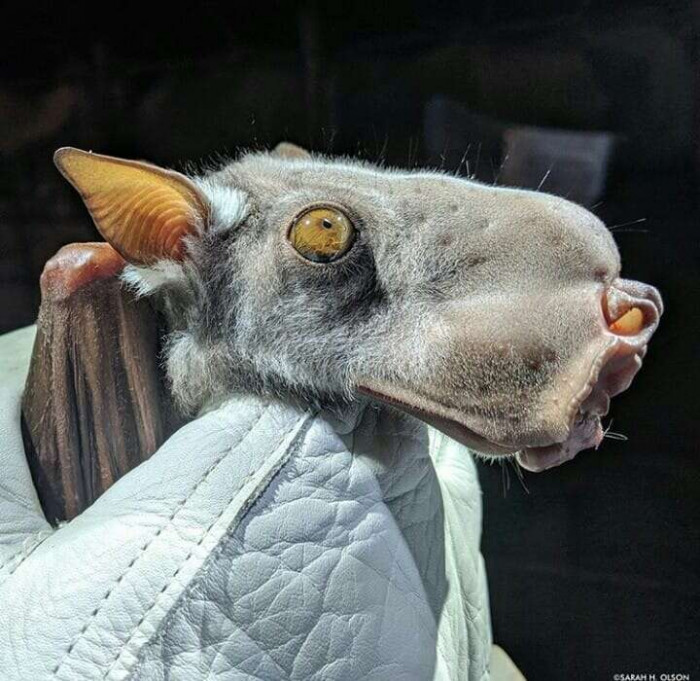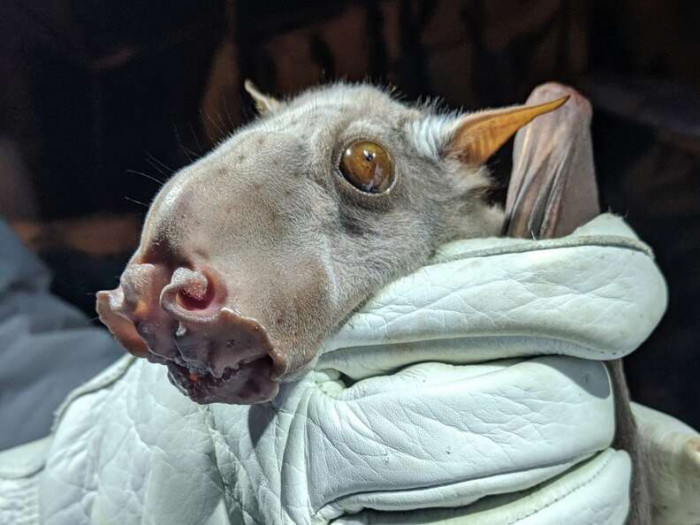
This Bat With A Huge Head Surprises People All Over The Internet With Its Peculiar Appearance
It has a head like no other and some people struggle to believe it is authentic.

For many many years, bats have had this reputation of being sinister and spooky. They've been the mascots of Halloween and in a lot of horror films, they're like this symbol of ominous happenings.
They've also been closely associated with bloodthirsty characters like Dracula and other monsters but their reputation most likely precedes them because of their razor-sharp fangs and beady eyes. Understandably, those things can frighten some people especially if you see them in the dark.
But they're not really bad, you know. Despite all the misconceptions surrounding them, bats are very important to humans and the environment.
More than 500 plant species, for instance, actually depend on bats for pollination like mangoes, bananas, and avocadoes. Insect-eating bats also consume millions of bugs at night which helps in pest control.
Fruit-eating bats also help disperse seeds which help rainforests grow which in turn helps mitigate the effects of deforestation.
There are also tons of bats out there in the world. In fact, there are 1 300 species making them the second most common group of mammals after rodents.
Some of them weigh less than a penny, others can be almost as large as a child and have a wingspan of six feet, and well, a few bats can even not look like bats like the one we have for you today.
Before you say that it's not a bat, we assure you, it is. It's not some weird hybrid made in a lab but a real-life bat.
Check it out.
The peculiar fruit bat:
 SARAH H. OLSON
SARAH H. OLSON
While most bats have a rodent or canine-like faces, these hammer-headed fruit bats have a completely different look unique to them. And while you might think they might have a hard time finding mates because of this difference, that's where you're wrong.
“The male’s moose-shaped head, curled lips, nasal folds, and enlarged larynx help him belt out repetitious calls for the female, which then change into a faster staccato when one is nearby,” Dr. Sarah H. Olson, an associate director of wildlife health at the Wildlife Conservation Society (WCS), said. “Their face acts as a resonating chamber.”
A "megabat."
 SARAH H. OLSON
SARAH H. OLSONThese bats look so different from the typical bat that's why a lot of people have a hard time believing they really exist but this megabat, which is actually the largest in Africa, is far from fantasy.
Large groups of male hammer-headed bats called leks can be found across the tropical forests of central Africa. You can usually see them hanging from trees and singing or honking at females flying by.
“Male hammer-headed bats make a peculiar calling sound at night to attract females, which makes them identifiable almost anywhere,” Olson said.
These bats are usually fond of keeping to themselves but lately, they've been getting more and more comfortable with closer contact with people.
“They don’t seek out interactions with humans per se, but they are sometimes found living nearby settlements and towns and will consume fruit crops,” Olson said. “One unanswered question is how human changes to the landscape may alter their interactions with people, with a concern that decreasing natural habitat may require them to shift their diet to just cultivated fruit trees, bringing people and bats into closer contact.”
It's kind of cute.
 SARAH H. OLSON
SARAH H. OLSON
Like all other kinds of fruit bats, the hammer-headed bat plays a very important role in helping tropical forests grow by dispersing seeds across the land. Olson and her teammates are studying the bats and their movements in hopes of helping and protecting these amazing creatures.
However, with deforestation and habitat loss, it's been an uphill battle.
“I just found out this week logging is starting near our research site in the northern Republic of Congo,” Olson said. “Our research site is a large mating arena, or lek, and I suspect if enough trees are lost, the bats may abandon a site they’ve used for at least 10 years, and maybe many more.”
If you have any doubt that these bats are special — all you need to do is look at one. “I think a picture is worth a thousand words,” Olson said.
These bats are definitely unique. Just one look will prove that to anyone who looks at it.
However, like most of their kind in the wild, they're also facing the consequences of human action. They're in danger of losing their homes and breeding grounds that they've used for years just because of human development.
Hopefully, something can be done fast to help save these bats before they become another addition to the endangered list.
What do you think about this bat?
Liezel







